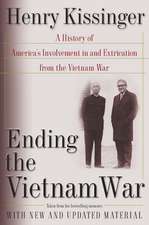D-Day: June 6, 1944: The Battle For The Normandy Beaches: Ambrose Simon & Schuster
Autor Stephen E. Ambroseen Limba Engleză Paperback – 4 mai 2016
| Toate formatele și edițiile | Preț | Express |
|---|---|---|
| Paperback (2) | 85.10 lei 3-5 săpt. | +20.99 lei 10-14 zile |
| Simon&Schuster – 4 mai 2016 | 85.10 lei 3-5 săpt. | +20.99 lei 10-14 zile |
| Simon&Schuster – 31 mai 1995 | 148.67 lei 3-5 săpt. |
Preț: 85.10 lei
Nou
16.28€ • 17.05$ • 13.47£
Carte disponibilă
Livrare economică 15-29 martie
Livrare express 04-08 martie pentru 30.98 lei
Specificații
ISBN-10: 1471158268
Pagini: 656
Ilustrații: 2x16pp plates
Dimensiuni: 130 x 198 x 45 mm
Greutate: 0.51 kg
Ediția:Reissue
Editura: Simon&Schuster
Colecția Simon & Schuster UK
Seria Ambrose Simon & Schuster
Notă biografică
Descriere
On the basis of 1,400 oral histories from the men who were there, bestselling author and World War II historian Stephen E. Ambrose reveals for the first time anywhere that the intricate plan for the invasion of France in June 1944 had to be abandoned before the first shot was fired. The true story of D-Day, as Ambrose relates it, is about the citizen soldiers - junior officers and enlisted men - taking the initiative to act on their own to break through Hitler's Atlantic Wall when they realised that nothing was as they had been told it would be. D-DAY is the brilliant, no holds barred, telling of the battles of Omaha and Utah beaches. Ambrose relives the epic victory of democracy on the most important day of the twentieth century.
Extras
THE DEFENDERS
At the beginning of 1944, Nazi Germany's fundamental problem was that she had conquered more territory than she could defend, but Hitler had a conqueror's mentality and he insisted on defending every inch of occupied soil. To carry out such orders, the Wehrmacht relied on improvisations, of which the most important were conscripted foreign troops, school-age German youths and old men, and fixed defensive positions. It also changed its tactical doctrine and weapons design, transforming itself from the highly mobile blitzkrieg army of 1940-41 that had featured light, fast tanks and hard-marching infantry into the ponderous, all-but-immobile army of 1944 that featured heavy, slow tanks and dug-in infantry.
Like everything else that happened in Nazi Germany, this was Hitler's doing. He had learned the lesson of World War I -- that Germany could not win a war of attrition -- and his policy in the first two years of World War II had been blitzkrieg. But in the late fall of 1941 his lightning war came a cropper in Russia. He then made the most incomprehensible of his many mistakes when he declared war on the United States -- in the same week that the Red Army launched its counteroffensive outside Moscow!
In the summer of 1942, the Wehrmacht tried blitzkrieg against the Red Army again, but on a much reduced scale (one army group on one front rather than three army groups on three fronts), only to come a cropper once more when the snow began to fall. At the end of January 1943, nearly a quarter of a million German troops at Stalingrad surrendered. In July 1943, the Wehrmacht launched its last offensive on the Eastern Front, at Kursk. The Red Army stopped it cold, inflicting horrendous casualties.
From Kursk on, Hitler had no hope of winning a military victory against the Soviet Union. That did not mean his cause was hopeless. He had a lot of space to trade for time on the Eastern Front, and in time it was inevitable that the strange alliance -- Great Britain, the Soviet Union, and the United States -- that only he could have brought together would split asunder.
His death and the total defeat of Nazi Germany would for certain lead to the breakup of the alliance, but Hitler wanted the breakup to take place while it would still benefit him, and he had good reason to believe that might happen -- if he could convince Stalin that he couldn't depend on the United States and Britain. In that event, Stalin could well conclude that the cost of victory to the Red Army fighting alone was too high. Once the Red Army had returned to the start line of June 1941 -- that is, in occupation of eastern Poland -- Stalin might be willing to negotiate a peace based on a division of Eastern Europe between the Nazis and Soviets.
Between August 1939 and June 1941 the Nazi and Soviet empires had been partners, joined together in an alliance based on a division of Eastern Europe between them. To return to that situation, Hitler had to persuade Stalin that the Wehrmacht was still capable of inflicting unacceptable casualties on the Red Army. To do that, Hitler needed more fighting men and machines. To get them, he had to strip his Western Front. To do that, he had to hurl the forthcoming invasion back into the sea.
That is why D-Day was critical. In a November 3, 1943, Führer Directive (No. 51), Hitler explained it all with crystal clarity: "For the last two and one-half years the bitter and costly struggle against Bolshevism has made the utmost demands upon the bulk of our military resources and energies....The situation has since changed. The threat from the East remains, but an even greater danger looms in the West: the Anglo-American landing! In the East, the vastness of the space will, as a last resort, permit a loss of territory even on a major scale, without suffering a mortal blow to Germany's chance for survival.
"Not so in the West! If the enemy here succeeds in penetrating our defense on a wide front, consequences of staggering proportions will follow within a short time." (What he meant was that a successful Anglo-American offensive in 1944 would pose a direct threat to Germany's industrial heartland, the Rhine-Ruhr region. Southeastern England is closer to Cologne, Düsseldorf, and Essen than they are to Berlin; put another way, in the fall of 1943 the front line in the East was more than 2,000 kilometers from Berlin, while in the West the front line was 500 kilometers from the Rhine-Ruhr, 1,000 kilometers from Berlin. A successful 1944 Red Army offensive would overrun parts of Ukraine and White Russia, areas important but not critical to Germany's war-making capability. A successful 1944 Anglo-American offensive would overrun the Rhine-Ruhr, areas that were indispensable to Germany's warmaking capability.)
Thus, Hitler declared, it was on the French coast that the decisive battle would be fought. "For that reason, I can no longer justify the further weakening of the West in favor of other theaters of war. I have therefore decided to strengthen the defenses in the West...."
This reversed a policy established in the fall of 1940, with the abandonment of preparations for Operation Seelöwe (Sea Lion), the invasion of England. Since that time, the Wehrmacht had stripped down its forces in France, transferring men and equipment to the Eastern Front on an ever-increasing scale.
Hitler's reasons for shifting priority to the West in 1944 were more political than military. On March 20, he told his principal commanders in the West, "The destruction of the enemy's landing attempt means more than a purely local decision on the Western Front. It is the sole decisive factor in the whole conduct of the war and hence in its final result." He went on to explain, "Once defeated, the enemy will never again try to invade. Quite apart from their heavy losses, they would need months to organize a fresh attempt. And an invasion failure would also deliver a crushing blow to British and American morale. For one thing, it would prevent Roosevelt from being reelected -- with any luck he'd finish up in jail somewhere! For another, war weariness would grip Britain even faster and Churchill, already a sick old man with his influence waning, wouldn't be able to carry through a new invasion operation." At that point, the Wehrmacht could transfer forty-five divisions from the West to the East to "revolutionize the situation there....So the whole outcome of the war depends on each man fighting in the West, and that means the fate of the Reich as well!"
This was Germany's only hope. More correctly, it was Hitler's and the Nazis' only hope; for the German people and nation, the decision to continue the struggle spelled catastrophe. In any case, had Hitler's scenario worked out, in the summer of 1945 the U.S. Army Air Force, secure in its bases in England, would have started dropping atomic bombs on Berlin and other German cities. But of course in early 1944 no one knew when, or even if, the American Manhattan Project would be able to produce such a bomb.
Hitler's problem was not his priorities, it was how to hurl the coming invasion back into the sea. That problem was compounded by many factors, summed up in one word -- shortages. Shortages of ships, planes, men, guns, tanks. Germany was overextended far worse than she had been in World War I. Hitler had criticized the Kaiser for getting into a two-front war, but at the end of 1943 Hitler was fighting a three-front war. On the Eastern Front, his troops were stretched over more than 2,000 kilometers; on the Mediterranean Front, which ran from southern Greece through Yugoslavia, then across Italy and southern France, his troops were defending a line of some 3,000 kilometers; on the Western Front, his troops were called on to defend 6,000 kilometers of coastline, running from Holland to the southern end of the Bay of Biscay.
Actually, there was a fourth front -- at home. The Allied air offensive against German cities had driven the Luftwaffe out of France, forcing it to fight over German skies to defend German cities. The bombing had not had a decisive effect on German war production -- not even close, as Germany was increasing its output of tanks and guns through 1943, although not fast enough to make up the losses -- but it had put the Luftwaffe on the defensive.
Hitler hated that. Everything in his own psychology, everything in German military tradition, cried out for taking the offensive. But Hitler could not attack his enemies, at least not until his secret weapons came on line. It was gall and wormwood to him, but he had to stay on the defensive.
That necessity so stuck in his craw that it led him to make strategic and technological blunders of the greatest magnitude. When German physicists told him in 1940 that it might be possible to build an atomic bomb by 1945, he ordered them to abandon the project on the grounds that by then the war would have been won or lost. That was almost certainly a wise decision, not because his prediction was accurate but because Germany did not have the industrial or natural resources to produce an atomic bomb. German scientists went to work instead on other weapons; at Hitler's insistence, these were offensive weapons such as diesel submarines, pilotless aircraft, and rockets. The Vergeltungswaffen (vengeance weapons) were designed and used, eventually, but in no way were they decisive. The V-2, the world's first medium-range ballistic missile, was not a military weapon at all but a terrorist device. (The Scud missiles used by Iraq in 1991 in the Gulf War were only slightly improved versions of the V-2; like the V-2, they were inaccurate and carried only a small explosive load.)
Hitler's passion for bombing London and his indifference to defending German cities led to a monstrous, history-changing misjudgment. In May 1943, Professor Willy Messerschmitt had an ME-262 twin-jet fighter ready for serial production. Its cruise speed was 520 miles per hour, more than 120 miles an hour faster than any plane the Allies could send against it, and it mounted four 30mm cannon. Reichsmarschall Hermann Goering wanted the plane, but he had to clear it with Hitler. Hitler had been burned by Goering's promises too many times, and not until December 1943 did Hitler witness a demonstration of the 262's capabilities. Hitler was impressed, but he wanted a bomber to hit London, not a fighter to defend Germany. Goering assured him that the 262 could be modified to carry bombs, whereupon Hitler went into great raptures about what the jet bomber would do to London and to the anticipated Allied landings in France.
Goering, typically, had not known what he was talking about. Messerschmitt could not make a fighter into a bomber, and a larger jet airplane was pushing the technology too hard. So he ignored Hitler's order and the Messerschmitt works started turning out 262s, a total of about 120 by April 1944. When Hitler got this news, he braced Goering and gave him strict orders that not only was the 262 not to be built as a fighter but that nobody should even refer to it as a fighter -- it was to be known as the Blitz-bomber.
For the next six months, Messerschmitt tried manfully to make a bomber out of a fighter. He got nowhere. Finally, in November 1944 Hitler authorized the formation of the first jet-fighter wing. But by then the transportation system was a shambles, the fighter-pilot force was decimated, and the fuel sources all but dried up. The Luftwaffe never got more than a token force into the air before things fell apart.
The Germans built more than 1,000 ME-262s, but only in the last six weeks of the war did they get as many as 100 in the air at one time. But as a secret report in 1960 to President Dwight Eisenhower pointed out, "During that time the Germans literally flew rings around our fighters and bored holes in our bomber formations with complete impunity....For example, 14 fighter groups escorted the 1,250 B-17 raid on Berlin March 18 [1945] -- almost a one-for-one escort ratio. They were set upon by a single squadron of ME 262's which knocked down 25 bombers and five fighters, although outnumbered roughly 100 to 1. The Germans lost not a single plane."
The report (which Eisenhower had asked to have prepared for his personal use only) was written by White House staff officer Ralph Williams. He said he had talked to Gen. Carl Spaatz, commander of the Eighth Air Force in World War II. Spaatz "freely conceded that none of our fighters was any match for the German jets, and...added that if the Germans had been able to get them deployed in force to the French coast they could have denied us air superiority and frustrated the Normandy landings and might even have compelled us to work our way up into Europe via the Italian route."
But what might have been wasn't; there were no German jets over France or the English Channel in June 1944, and precious few prop airplanes.
There were also precious few ships of war, and those that were there were E-boats, an oversize German version of the American patrol boat (PT boat), almost as big as a destroyer escort (the E stood for "enemy"). They were capable of laying mines and firing torpedoes and running away at high speed. Other than the E-boats, the only contribution the German navy could make to the defense of Fortress Europe was minelaying.
With no air force and no navy, the German defenders of Fortress Europe were blind and forced to stretch out to cover every conceivable landing site. Control of the air and sea gave the Allies unprecedented mobility and almost certain surprise -- in briefest form, they would know where and when the battle would be fought, and the Germans would not.
In World War I, preparations for a massive offensive could not be hidden. The buildup of troops took weeks; the artillery preparation took days; by the time the offensive began, the defenders knew where and when it would hit and could strengthen their positions at the point of attack. But in the spring of 1944, the Germans could only guess.
Hitler's spiritual mentor, Frederick the Great, had warned, "He who defends everything, defends nothing."
It was the human and material wastage of the war on the Eastern Front that forced Hitler to ignore Frederick's warning and adopt a policy on the Western Front of fixed fortifications. Wehrmacht losses had been staggering. In June 1941, the Wehrmacht went into Russia with 3.3 million men. By the end of 1943 it had suffered nearly 3 million casualties, about one-third of which were permanent (killed, missing, captured, or unfit for combat due to wounds). Despite heroic efforts to make up the deficit by drawing down in France and calling up fresh conscripts from within Germany, after the Kursk battle (next to Verdun, the greatest battle ever fought, with more than 2 million men engaged) the Wehrmacht on the Eastern Front was down to 2.5 million, attempting to hold a line that stretched from Leningrad in the north to the Black Sea in the south, nearly 2,000 kilometers.
When the Wehrmacht invaded the Soviet Union, it prided itself on its "racial purity." The desperate need for replacements forced it to drastically modify and eventually abandon that policy. Initially, so-called Volksdeutsche ("racial Germans") from Poland and the Balkan countries were required to "volunteer." They were classified as Abteilung 3 dur Deutschen Volkslists (Section 3 of the German Racial List); this meant that they were vested with German citizenship for a probationary period of ten years and were liable to military service but could not rise above the rank of private first class. In 1942-43 recruiting in the occupied territories of the Soviet Union was aggressively pursued for the struggle against communism; initially there was some truth to the designation of these recruits as Freiwilligen (volunteers), as men from the western republics of the Soviet empire signed up for the fight against Stalin. When the German retreat began, there were fewer Freiwilligen, more Hilfswilligen (auxiliaries) conscripted from the occupied territories and from Red Army prisoners of war. By the beginning of 1944, the Wehrmacht had "volunteers" from France, Italy, Croatia, Hungary, Romania, Poland, Finland, Estonia, Latvia, Lithuania, Asian Russia, North Africa, Russia, Ukraine, Ruthenia, the Muslim republics of the Soviet Union, as well as Volga-Tatars, Volga-Finns, Crimean Tatars, and even Indians.
The so-called Ost (east) battalions became increasingly unreliable after the German defeat at Kursk; they were, therefore, sent to France in exchange for German troops. At the beach called Utah on the day of the invasion, Lt. Robert Brewer of the 506th Parachute Infantry Regiment, 101st Airborne Division, U.S. Army, captured four Asians in Wehrmacht uniforms. No one could speak their language; eventually it was learned that they were Koreans. How on earth did Koreans end up fighting for Hitler to defend France against Americans? It seems they had been conscripted into the Japanese army in 1938 -- Korea was then a Japanese colony -- captured by the Red Army in the border battles with Japan in 1939, forced into the Red Army, captured by the Wehrmacht in December 1941 outside Moscow, forced into the German army, and sent to France. (What happened to them, Lieutenant Brewer never found out, but presumably they were sent back to Korea. If so, they would almost certainly have been conscripted again, either into the South or the North Korean army. It is possible that in 1950 they ended up fighting once again, either against the U.S. Army, or with it, depending on what part of Korea they came from. Such are the vagaries of politics in the twentieth century.) By June 1944, one in six German riflemen in France was from an Ost battalion.
Furthermore, the Wehrmacht sharply relaxed its physical standards to bring more genuine Germans into the line. Men with stomach and lung ailments were sent to the front. Convalescence time was cut, as was training time for recruits. Younger and older men were called up; of an army of 4,270,000 men in December 1943, more than a million and a half were over thirty-four years old; in the 709th Division, on the Cotentin Peninsula, the average age was thirty-six; in the Wehrmacht as a whole the average age was thirty-one and a half (in the U.S. Army the average age was twenty-five and a half). Meanwhile, the classes of 1925 and 1926 were called up.
As a consequence of these desperate measures, the Wehrmacht did not have the resources to conduct a defense in depth, based on counterattacks and counteroffensives. It lacked sufficient high-quality troops, it lacked sufficient mobility, it lacked sufficient armor. The old men, boys, and foreign troops were of value only if they were put into trenches or cement fortifications, with German NCOs standing behind them, pistol in hand, ready to shoot any man who left his post.
In 1939 Hitler had characterized the Wehrmacht as "an army such as the world has never seen." It was far from that at the end of 1943. The U.S. War Department described the German soldier as "one of several different types....The veteran of many fronts and many retreats is a prematurely aged, war weary cynic, either discouraged and disillusioned or too stupefied to have any thought of his own. Yet he is a seasoned campaigner, most likely a noncommissioned officer, and performs his duties with the highest degree of efficiency.
"The new recruit, except in some crack SS [Schutzstaffel, or Protection Detachment] units, is either too young or too old and often in poor health.
"He has been poorly trained for lack of time but, if too young, he makes up for this by a fanaticism bordering on madness. If too old, he is driven by the fear of what his propagandists have told him will happen to the Fatherland in case of an Allied victory, and even more by the fear of what he has been told will happen to him and his family if he does not carry out orders exactly as given. Thus even the old and sick perform, to a certain point, with the courage of despair.
"The German high command has been particularly successful in placing the various types of men where they best fit, and in selecting those to serve as cannon fodder, who are told to hold out to the last man, while every effort is made to preserve the elite units, which now are almost entirely part of the Waffen-SS [combat troops of the SS]. The German soldier in these units is in a preferred category and is the backbone of the German Armed Forces. He is pledged never to surrender and has no moral code except allegiance to his organization. There is no limit to his ruthlessness."
Beyond the Waffen-SS, the best of the young recruits went into the Fallschirmjäger (paratroop) or panzer (armored) units. These elite troops had been carefully brought up in Nazi Germany for just this challenge. Born between 1920 and 1925, they had grown up in Hitler's Germany, subject to constant and massive propaganda, members of the Nazi Youth. Given good equipment -- and they got the best Germany could produce, which in small arms, armored vehicles, and artillery was among the best in the world -- they made first-class fighting outfits.
In naturally strong coastal defenses made stronger by the skill of German engineers, even second- and third-class troops could inflict heavy casualties on an attacking force. Hitler roundly declared that it was a soldier's duty "to stand and die in his defenses." That was a World War I mentality, a far cry from blitzkrieg, inappropriate to the age of tanks and other armored vehicles, but, given the situation, inevitable. What gave the concept some believability was the plan to use the crack Waffen-SS, paratroops, and armored troops in an immediate counterattack. At the end of 1943 those troops and tanks were still on the Eastern Front, or forming up inside Germany, but Hitler's directive of November 3, 1943, meant that many of them, perhaps enough, would be standing just behind the Atlantic Wall when the assault began.
As early as March 1942, Hitler laid down the basic principle in Directive No. 40. He ordered that the Atlantic coast defenses should be so organized and troops so deployed that any invasion attempt be smashed before the landing or immediately thereafter. In August 1942, he decreed that fortress construction in France proceed with Fanatismus (fanatic energy), to create a continuous belt of interlocking fire emanating from bombproof concrete structures. In the words of the official American historian, Gordon Harrison, "Hitler was not then, and never would be, convinced that defense could not be made invulnerable if enough concrete and resolution could be poured into it."
In September 1942, at a three-hour conference with Goering, Reich Minister Albert Speer (chief of Organization Todt, the German construction organization), Field Marshal Gerd von Rundstedt, commander in the West, Gen. Guenther Blumenstedt (chief of staff, Oberbefehlshaber West -- OB West, the German ground headquarters of the Western Front), and others, Hitler reiterated his orders to prepare the strongest possible fixed fortifications along the Atlantic Wall. They must be built, he said, on the assumption that the Anglo-Americans would enjoy air and naval supremacy. Only concrete could stand up to the crushing weight of bombs and shells. He therefore wanted 15,000 concrete strong points to be occupied by 300,000 men. As no portion of the coast was safe, the whole would have to be walled up. He wanted the fortifications completed by May 1, 1943.
Most of this was pure fantasy and, aside from the toppriority positions, almost none of it was accomplished at the end of 1943. But the policy had been set, the commitment made.
Rundstedt was unhappy with the idea of fixed fortifications. He argued that the Germans should hold their armored units well back from the coast, out of range of Allied naval gunfire, capable of mounting a genuine counteroffensive. But shortages of armor, men, fuel, and air coverage made that questionable.
What Hitler could do was attempt to anticipate the landing site, keep what armor was available for the West near that place, and use it for local counterattacks while the Atlantic Wall held up the invaders. Tanks could seal off any penetration; tanks could drive the lightly armed and unarmored first wave of invaders back into the sea, if the fortifications were strong enough to keep the Allies from establishing momentum. The trick was to pick the place to make the fortifications that strong.
The Pas-de-Calais was the logical place for the invasion for two overwhelming reasons: between Dover and Calais is where the English Channel is narrowest, and the straight line from London to the Rhine-Ruhr and on to Berlin runs London-Dover-Calais-Belgium.
Hitler had to make a bet, and in 1943 he bet the invasion would come at the Pas-de-Calais. In a way, he tried to force the Allies to invade there. In the summer of 1943, he decided to install the launching sites for the V-1 and V-2 Vergeltungs weapons in that area. He believed that whatever the Allies' previous plans might have been, the V weapons would be so dangerous as to force them to attack directly in the Pas-de-Calais in order to overrun the launching sites.
Thus the area around Calais became by far the strongest fortified portion of the Kanalküste (Channel coast), and in 1944 the location of by far the greatest concentration of German armor in the West. It was there that the Atlantic Wall came closest to what German propaganda claimed it was, an impregnable fortress.
He was a strange man, the German führer. In the view of the deputy chief of operations at Oberkommando der Wehrmacht (OKW), Gen. Walter Warlimont, "He knew the location of the defenses in detail better than any single army officer." Hitler's passion for detail was astonishing. On one occasion, he pointed out that there were two fewer antiaircraft guns on the Channel Islands than had been there the previous week. The officer responsible for this supposed reduction was punished. It turned out to have been a miscount.
Hitler spent hours studying the maps showing German installations along the Atlantic Wall. He demanded reports on building progress, the thickness of the concrete, the kind of concrete used, the system used to put in the steel reinforcement -- these reports often ran to more than ten pages. But, after ordering the creation of the greatest fortification in history, he never bothered to inspect any part of it. After leaving Paris in triumph in the summer of 1940, he did not set foot on French soil again until mid-June 1944. Yet he declared this was the decisive theater!
Copyright © 1994 by Ambrose-Tubbs, Inc.
Cuprins
Contents
Prologue
1 The Defenders
2 The Attackers
3 The Commanders
4 Where And When?
5 Utilizing Assets
6 Planning and Preparing
7 Training
8 Marshaling and Briefing
9 Loading
10 Decision to Go
11 Cracking the Atlantic Wall
The Airborne into Normandy
12 "Let's Get Those Bastards"
The Airborne Night Attack
13 "The Greatest Show Ever Staged"
The Air Bombardment
14 A Long, Endless Column of Ships
The Naval Crossing and Bombardment
15 "We'll Start the War from Right Here"
The 4th Division at Utah Beach
16 "Nous Restons Ici"
The Airborne in the Cotentin
17 Visitors to Hell
The 116th Regiment at Omaha
18 Utter Chaos Reigned
The 16th Regiment at Omaha
19 Traffic Jam
Tanks, Artillery, and Engineers at Omaha
20 "I Am A Destroyer Man"
The Navy at Omaha Beach
21 "Will You Tell Me How We Did This?"
The 2nd Ranger Battalion on D-Day Morning
22 Up the Bluff at Vierville
The 116th Regiment and 5th Ranger Battalion
23 Catastrophe Contained
Easy Red Sector, Omaha Beach
24 Struggle for the High Ground
Vierville, St.-Laurent, and Colleville
25 "It Was Just Fantastic"
Afternoon on Omaha Beach
26 The World Holds Its Breath
D-Day on the Home Fronts
27 "Fairly Stuffed With Gadgets"
The British Opening Moves
28 "Everything Was Well Ordered"
The 50th Division at Gold Beach
29 Payback
The Canadians at Juno Beach
30 "An Unforgettable Sight"
The British at Sword Beach
31 "My God, We've Done It"
The British Airborne on D-Day
32 "When Can Their Glory Fade?"
The End of the Day
Glossary
Endnotes
Bibliography
Appendix A: Veterans who contributed oral histories or written memoirs to the Eisenhower Center
Index
Maps
The Final Overlord Invasion Plan
German Strength in Western Europe
Landing Diagram, Omaha Beach
Utah Beach Airborne Assault on D-Day
The Allied Assault Routes on D-Day
Utah Beach Infantry Assault on D-Day
Omaha Beach First Wave Landings on D-Day
Omaha Beach Eastern Sector
Omaha Beach Evening of D-Day
Recenzii
Raleigh Trevelyan The New York Times Book Review D-Day is mostly about people, but goes even further in evoking the horror, the endurance, the daring and, indeed, the human failings at Omaha Beach...Outstanding.
Christopher Lehmann-Haupt The New York Times Reading this history, you can understand why for so many of its participants, despite all the death surrounding them, life revealed itself in that moment at that place.
Thomas B. Buell Chicago Tribune Historians and public alike should be profoundly grateful to Ambrose...for assembling this comprehensive and permanent record that will be forever a resource for remembering Normandy.





























